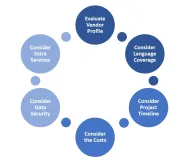Quick Guide To Product Information Management (PIM) in 2024
The 2 main functions of a supply chain are the downstream flow of products/services and the upstream flow of information. However, as supply chains incorporate more third-party companies, such as offshore suppliers and logistics service providers, they transform into supply networks. In such diverse supply networks, information flows in all directions rather than just upstream. Product information is one important element that is generated and managed in such information streams and is used for marketing and selling products and services.
As companies expand1 their product lines, they generate and move more product information. That is when product information management (PIM) comes into play. Proper management of product information starts with the selection of the right method, and this decision can sometimes be difficult for business managers.
This article is curated to explore:
- What is product information management (PIM)?
- Why do you need it in your business?
- And what is PIM software?
What is product information management (PIM)?
Product information management, or PIM, is the process of managing all the information needed to market and sell a product across all the company’s distribution channels. It is also the process of enriching product data to make the purchasing experience more engaging for the customers and ensure that the product successfully sells.
Data used in PIM includes information mainly utilized by the marketing and sales teams, for instance, product specifications, dimensions, features, etc.
Why do you need product information management (PIM)?
Departments such as marketing, sales, merchandising, product management, eCommerce, etc., depend on product information to function. However, while working with large product lines, using manual processes and siloed systems can make things inefficient. Centralized PIM enables efficient storage and management of that information and makes it available to all relevant teams on demand.
However, PIM is not only beneficial for large businesses. Brands with small product lines can also benefit from PIM since they need to modify their products and need to manage data related to those upgrades or changes.
Benefits of PIM include:
- Easy access: All relevant teams can easily access the data since it is centrally stored.
- Easy to share: If the engineering team makes any changes to the design, it can easily update the data and make it visible to all other teams.
- Increased efficiency: The PIM system provides a one-stop solution to all teams, so they do not need to waste time searching for the data.
- Improve customer experience: Since the data is regularly updated, it offers customers more accurate descriptions, resulting in a better overall purchasing experience.
What is product information management software?
Product information management software is an application that allows the efficient storage and management of product information in a central system, accessible to all relevant teams.
Here is how PIM software can work in an organization:
- The engineering team makes some changes to an existing product and adds that information to the central PIM system.
- The system overwrites/updates the existing information of that particular product and makes it available to all other teams.
- The product management team sees these changes and updates the product’s price according to the changes made by the engineering team in the PIM system. The PIM system automatically updates the price on all distribution channels.
- The E-commerce team also accesses that updated information from the central PIM system without worrying about its freshness and updates the product description on the PIM system. The PIM system then automatically updates that product description on all distribution channels.
On a basic level, PIM software can enable you to efficiently:
- Gather, manage, and enrich product information,
- Create product catalogs with updated descriptions,
- Distribute information to relevant teams
Why is PIM software important?
As previously mentioned, manual PIM is not possible since products are now frequently upgraded. Tesla2, for instance, uses an agile methodology in its product development operations, where product development is integrated with manufacturing. This means that car modifications and improvements are made much more frequently than in regular car production systems.
As these minor and frequent changes, which can happen at any stage of the production process, are made, they must be known by all the other departments. Managing product information of such a business model requires sophisticated PIM software that enables real-time integration.
PIM software integrations
A PIM software can/cannot be integrated with the following systems:
- PIM & Inventory management software: PIM software does not include inventory management software and can not keep track of the inventory of your products
- PIM & Content Management Software: PIM software does not include content management features; however, it can be integrated with content management software.
- PIM & ERP: PIM software is not ERP software; however, good PIM software can be integrated with an ERP system.
- PIM & DAM: PIM software in the past did not have digital asset management (DAM) capabilities, but good PIM software includes them.
Further reading
- Product Data Collection: What it is & Top 3 methods
- Elevate Your Online Business with Product Data Management
If you need help finding a vendor or have any questions, feel free to contact us:
References
- Twin, Alexandra (May 16, 2022). “Product Lines Defined and How They Help a Business Grow”. Investopedia. Retrieved: Nov 16, 2022.
- Krueger, Jens (Dec 22, 2021). “Product development at Tesla”. LinkedIn. Retrieved: Nov 16, 2022.



Comments
Your email address will not be published. All fields are required.